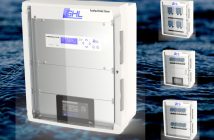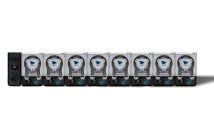
Refugium and Equipment
Though the benefits of a refugium greatly outweigh any potential downsides, there are a few potential dangers that are accompanied by the existence of a refugium in the aquarium system.
What is a Refugium?

Refugium with Macroalgae
The refugium is a very important tool for successful reef aquariums. They are simply another aquarium located under the display aquarium where the protein skimmer and macroalgae (caulerpa and chaetomorpha for example) are housed. The protein skimmer is a potentially large filtration device. It functions by injecting air and water into a large cylindrical tube via water pump with a . As the bubble rise, they attract dissolved organics to their surfaces. The bubbles eventually reach the top and burst, depositing the collected organics into a collection cup. The protein skimmer is the single most important piece of aquarium filtration equipment.

Grape Caulerpa
Macroalgae is the one feature that separates a refugium from a sump. A sump and refugium both serve to house filtration underneath the aquarium and out of sight, but unlike a sump, the refugium houses macroalgae for natural filtration. The algae grows undisturbed and filters nitrates and phosphates from the water.
Potential Dangers…
Though rare, the refugium can cause severe issues for an established aquarium. The most common issue that people run into is macroalgae (predominantly caulerpa) going “sexual”. What happensis the plant begins to dissolve, releasing gametes and an abundance of nutrients. The water in the

Grape Caulerpa
aquarium will turn cloudy, and unless immediate action is taken, a full tank crash can occur.
In addition to going “sexual”, macroalge can simply not receive enough nutrients and can slowly die off. The algae will slowly break apart and dissolve, and unless you’re on top of regular maintenance and inspection, it will become a source of nutrients rather than a solution.
The last potential danger (more like a nuisance) that can occur is the buildup of detritus and excess waste. Since the refugium is full of baffles (dividers) and is designed for a slow flow, fish waste can easily accumulate in the bottom of each section of the refugium. The macroalgae can also trap a large amount of

Grape Caulerpa and Chaetomorpha
detritus, which will continue to decay and release nitrates and phosphates back into the aquarium. The simple solution to this of course would be to siphon out any visible detritus.
The best way to resolve any potential issues with a refugium is to monitor the algae on a regular basis, siphon out any detritus, and make sure the algae is properly illuminated. These minor issues can become major if they are ignored, but the refugium will work flawlessly if the appropriate maintenance is performed.
Sources:
All images provided by the author






Pingback: Interesting Blog Articles - Reef Aquarium()